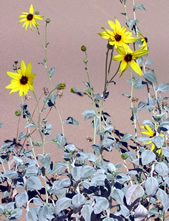This page has been archived and is being provided for reference purposes only. The page is no longer being updated, and therefore, links on the page may be invalid.
ARS Diversifies Sunflower Traits
By Jan SuszkiwDecember 29, 2004
Wild sunflowers--whether growing beside a fast-food restaurant parking lot or clinging to shifting sand dunes--are worth their weight in gold to Agricultural Research Service (ARS) scientists.
Wild species seeds, according to the researchers, contain genes for improving cultivated sunflower and bolstering its resistance to insect pests and diseases. Genes from one such species led to cytoplasmic male sterility, the mechanism by which today's sunflower breeders develop new sunflower hybrids. The economic value of traits already bred into cultivated sunflower from wild species is an estimated $267 million to $384 million annually.
ARS scientists have been collecting wild sunflowers since 1976, amassing representative populations of the 50 known Helianthus species, according to scientists Tom Gulya and Gerald Seiler, in the ARS Sunflower Research Unit, Fargo, N.D. Accessions are placed in the ARS National Plant Germplasm System (NPGS) at Ames, Iowa, for safekeeping and distribution to sunflower researchers worldwide.
The Fargo unit is a clearinghouse of sorts for newly collected specimens en route to being catalogued and stored at NPGS. Seeds are first evaluated for weight, oil content and fatty acid composition. The new accessions are then tested for possible resistance to economically important sunflower diseases.
H. annuus is the predominant Helianthus species kept at NPGS, which has 2,163 accessions. H. annuus' preference for disturbed soils--like roadside grading and constructions sites--indicates the species' tenacity and adaptability, according to Gulya. Others are habitat-specific and vulnerable to human activity. In Texas, road projects pushed aside populations of H. paradoxus. Fortunately, new ones were found in New Mexico. Now, H. paradoxus' seed is in safe storage, including its genes for breeding salt- and drought-tolerant hybrids.
Seiler and Gulya collect sunflowers once or twice a year, typically driving 2,500 to 3,000 miles per trip, much of that on back roads. They map and describe each new site so future collections can be made. They estimate at least one trip annually for the next 10 years will be needed to collect all remaining species native to the United States.
ARS is the U.S. Department of Agriculture's chief scientific research agency.



